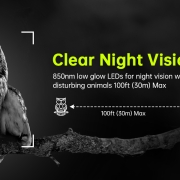Hunting Camera
How to Choose the Best Trail Camera-Hiicam
When choosing the right hunting camera, several key factors come into play to ensure you get the best device for your needs:
1. Image Quality (Resolution)
- Photo & Video Resolution: Higher resolution cameras capture more detailed images and videos. Look for at least 12MP for photos and 1080p for videos, though 4K options are increasingly available.
- Low-Light Performance: A good hunting camera should work well in low-light conditions, especially at dawn or dusk when game is most active. Infrared or low-glow LEDs can improve night vision without startling animals.
2. Detection Range & Speed
- Trigger Speed: The time it takes from when motion is detected to when the camera takes a picture. A faster trigger speed (less than 0.5 seconds) ensures you capture quick-moving animals.
- Detection Range: This is how far away the camera can detect movement. A longer detection range (60-100 feet) allows the camera to capture more of the environment.
3. Battery Life
- Hunting cameras are often left unattended for long periods, so battery life is crucial. Consider cameras with energy-efficient modes or options that support solar panels for extended use.
4. Memory and Storage
- SD Card Capacity: Choose a camera that supports high-capacity SD cards (32GB or more) so you don’t have to retrieve it as often.
- Overwrite Functionality: Some cameras can overwrite the oldest files when the memory card is full, ensuring you don’t miss any new footage.
5. Weatherproofing and Durability
- Since hunting cameras are placed outdoors, they should be weather-resistant and able to withstand rain, snow, heat, and cold. Look for IP ratings (e.g., IP66 or IP67) for water and dust resistance.
6. Camouflage and Mounting Options
- To avoid detection by both animals and humans, the camera should have a camouflage pattern or color that blends into the environment. Ensure it comes with sturdy mounting options like straps or brackets for flexible installation.
7. Connectivity Features
- Wireless Transmission: Some cameras offer wireless connectivity via cellular or Wi-Fi, enabling you to receive real-time updates on your phone or computer.
- App Integration: Many modern cameras have apps that allow you to manage settings, view footage remotely, and even adjust the camera angle.
8. Price vs. Features
- Consider the balance between cost and features. Some cameras may have advanced capabilities like GPS tagging or time-lapse modes but at a higher price. Determine which features are essential for your needs.
9. No-Glow or Low-Glow LEDs
- For night-time captures, no-glow (invisible) or low-glow (faint red glow) LEDs help avoid spooking animals while still providing enough illumination to capture images or videos.
If you’re looking into Hiicam hunting cameras, they often come equipped with high detection speeds, durable waterproof designs, and long battery life, making them reliable for both professional hunters and outdoor enthusiasts.















